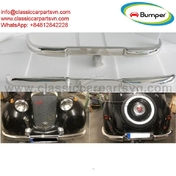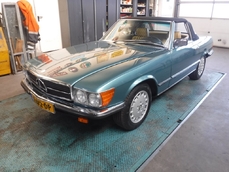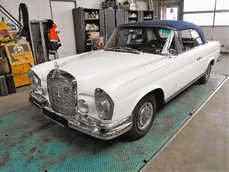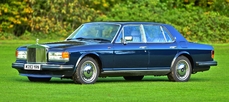Mercedes-Benz Other Motor Wagen 2005
Allmän beskrivning :
View vehicle on YouTube
1886 Benz Patent Motor Wagen Replica.Chassis number: TBA
Registration number: TBA
Vintage and Prestige Fine Motor Cars are proud to be offering this 1886 Benz Patent-Motorwagen Replica for sale. The Benz Patent-Motorwagen (or motorcar), built in 1886, is widely regarded as the world's first automobile. The original cost of the vehicle in 1885 was $1,000 (equivalent to $26,337 in 2016). This is an exact replica of the original, painstakingly constructed with reference to the original plans.The quality is superb making the Benz easy to drive. It is in brand new condition having just covered some bedding in miles.
The original Benz Patent-Motorwagen was awarded the German patent, number 37435, for which Karl Benz applied on January 29, 1886. Following official procedures, the date of the application became the patent date for the invention once the patent was granted, which occurred in November of that year.
Although Benz's wife, Bertha, financed the development process and would hold patent rights under modern law as a married woman, she was not allowed to apply for the patent.
Benz officially unveiled his invention to the public on July 3, 1886, on the Ringstrasse (Ringstraße) in Mannheim.
About 25 Patent Motorwagens were built between 1886 and 1893.
The Benz Patent-Motorwagen was a three-wheeled automobile with a rear-mounted engine. The vehicle contained many new inventions. It was constructed of steel tubing with woodwork panels. The steel-spoked wheels and solid rubber tires were Benz's own design. Steering was by way of a toothed rack that pivoted the un-sprung front wheel. Fully elliptic springs were used at the back along with a live axle and chain drive on both sides. A simple belt system served as a single-speed transmission, varying torque between an open disc and drive disc.
The first Motorwagen used the Benz 954 cc single-cylinder four-stroke engine
With trembler coil ignition, this new engine produced 2⁄3 horsepower (0.50 kW) at 250rpm in the Patent-Motorwagen, although later tests by the University of Mannheim showed it to be capable of .9 hp (0.67 kW) at 400 rpm. It was an extremely light engine for the time, weighing about 100 kg (220 lb). Although it’s open crankcase and drip oiling system would be alien to a modern mechanic, its use of a pushrod operated poppet valve for exhaust would be quite familiar.
A large horizontal flywheel stabilized the single-cylinder engine's power output. An evaporative carburetor was controlled by a sleeve valve to regulate power and engine speed. The first model of the Benz Motorwagen had not been built with a carburetor, rather a basin of fuel soaked fibers that supplied fuel to the cylinder by evaporation.
Benz later made more models of the Motorwagen, model number 2 boasting 1.5 hp (1.1 kW), and model number 3 with 2 hp (1.5 kW), allowing the vehicle to reach a maximum speed of approximately 10 mph (16 km/h). The chassis was improved in 1887 with the introduction of wooden-spoke wheels, a fuel tank, and a manual leather shoe brake on the rear wheels.
Historic drive of Bertha Benz
The Benz Patent-Motorwagen Nr. 3 of 1888, used by Bertha Benz for the first long distance journey by automobile (more than 96 km or sixty miles)
Bertha Benz, married to Karl, chose to publicise the Patent-Motorwagen in a unique manner. She took the Patent-Motorwagen No.3, supposedly without her husband's knowledge, and drove it on the first long-distance automobile road trip to demonstrate its feasibility as a means to travel long distances. That trip occurred in early August 1888, as the entrepreneurial lady took her sons, Eugene and Richard who were fifteen and fourteen years old, respectively, on a ride from Mannheim through Heidelberg, and Wiesloch (where she took on ligroin as a fuel at the city pharmacy making it the first filling station in history), to her maternal hometown of Pforzheim.
As well as being the driver, Benz acted as mechanic on the drive, cleaning the carburetor with her hat pin and using a garter to insulate a wire. She refueled at the local pharmacy in Wiesloch and as the brakes wore down, Benz asked a local shoemaker to nail leather on the brake blocks, in doing so, inventing brake lining on the way. After sending a telegram to her husband of the arrival in Pforzheim, she spent the night at her mother's house and returned home three days later. The trip covered 194 km (121 mi) in total.
In Germany, a parade of antique automobiles celebrates this historic trip of Bertha Benz every two years. In 2008, the Bertha Benz Memorial Route was officially approved as a route of industrial heritage of mankind, because it follows Bertha Benz's tracks of the world's first long-distance journey by automobile in 1888. Now everybody can follow the 194 km (121 mi) of sign posted route from Mannheim via Heidelberg to Pforzheim (Black Forest) and back.
https://youtu.be/TjZLFJliuR0
2005 Mercedes-Benz Other Motor Wagen is listed till salu on ClassicDigest in Essex by Prestige House for Ej prissatt.
Fakta i bilen
Karosstyp : Personbil Märke : Mercedes-Benz Modell : Other Modellversion : Motor Wagen Motorvolym : 0.0 Årsmodell : 2005 Karosstyp : Pick up Läge : Essex Fordon Registrering : Odefinierad
Ej prissatt
Information om säljaren
Vintage & Prestige
Prestige House
+44(0)1375 379719, +44(0)7967 260673
Prestige House
+44(0)1375 379719, +44(0)7967 260673
People who viewed this Mercedes-Benz Other also viewed similar Mercedes-Benz listed at ClassicDigest
Other cars listed for sale by this dealer
om Mercedes-Benz
I automobilhistoriens krönika utvecklas Mercedes-Benzs resa som en berättelse fylld av uppfinningsrikedom från sina grundande pionjärer. År 1886 skapade Karl Benz Benz Patent Motorwagen, en skapelse som skulle gå till historien som världens första bil. Okunnig om detta markerade stunden början på det som skulle utvecklas till den mest ansedda premium-biltillverkaren globalt. Den ekonomiska grundvalen för detta banbrytande företag tillhandahölls intressant nog av Karl Benz fru, Bertha Benz, vilket visade på ett anmärkningsvärt partnerskap som skulle sätta tonen för Mercedes-Benzs arv.Inte långt därifrån framträdde en parallell berättelse när Daimler-Motoren-Gesellschaft, grundat av Gottlieb Daimler och Wilhelm Maybach, kom in på scenen. År 1901 avslöjade de sin bil under det nu berömda namnet "Mercedes", vilket betyder "guds gåva" på spanska. Detta namn tilldelades bilen på begäran av Emil Jellineks dotter, distributören för Daimler-Motoren-Gesellschaft. Innovationshjulen sattes i rörelse.
Hoppa fram till 1926, ett avgörande år som bevittnade sammanslagningen av Daimler med Benz & Cie., vilket resulterade i födelsen av Daimler-Benz. Sammanslagningen innebar antagandet av "Mercedes-Benz" som det framstående varumärket för deras bilar och förenade arvet från två visionära enheter till en.
I motsats till uppfattningen om konservatism vecklar sig Daimler-Benzs bana ut som en krönika av branschens första. Från introduktionen av honungskaksradiatorn till flytkarburatorn och den banbrytande implementeringen av fyrhjulsbromsar 1924 pressade Daimler-Benz konsekvent gränserna för bilinnovation. Den dieselkraftade Mercedes-Benz 260 D från 1936 markerade starten för dieselmotorer i personbilar. Den ikoniska Mercedes-Benz 300SL Gullwing gjorde historia som den första bilen med direkt bränsleinsprutning, även om Gutbrods lilla 2-taktsmotor kan göra anspråk på företräde.
Säkerhetsinnovationer blev en kännetecken, med Béla Barényis patenterade säkerhetscell i "Ponton"-modellerna 1951 med främre och bakre deformationszoner. W116 450SEL 6.9 såg införandet av Anti-Lock Brake System (ABS), ytterligare en banbrytande säkerhetsfunktion. Från de första serietillverkade krockkuddarna och därefter fortsatte "första" att etsas in i Daimler-Benzs tyg.
Under sin över hundra år långa resa har Mercedes-Benz inte bara producerat bilar utan har skulpterat ikoner. SSKL, 710 SSK Trossi Roadster, 770K Grosser, 540K Spezial Roadster, 300SL Gullwing, w100 600 Pullman, w111 280SE 3.5 Flachkühler, w113 230SL Pagoda, w109 300 SEL 6.3 och w201 2.3-16 Cosworth vittnar om märkets engagemang för ingenjörsexcellens.
De dånande Silver Arrows, eller "Silberpfeile", inklusive W 25, W 125, W154, W165 och W196, skapade ett arv av dominans på racerbanan. Dessa maskiner var inte bara bilar; de var uttryck för precision, hastighet och en oövervinnelig anda som lämnade sina konkurrenter i dammet.
När Mercedes-Benz går in i framtiden gör det inte bara som en biltillverkare utan som en förvaltare av ett arv, en fackelbärare av innovation och en fyr av bilaexcellens. Vägen framåt kommer säkerligen att bevittna den fortsatta föreningen av toppmodern teknik, tidlös design och ett obevekligt åtagande att sätta nya standarder inom bilvärlden.

























